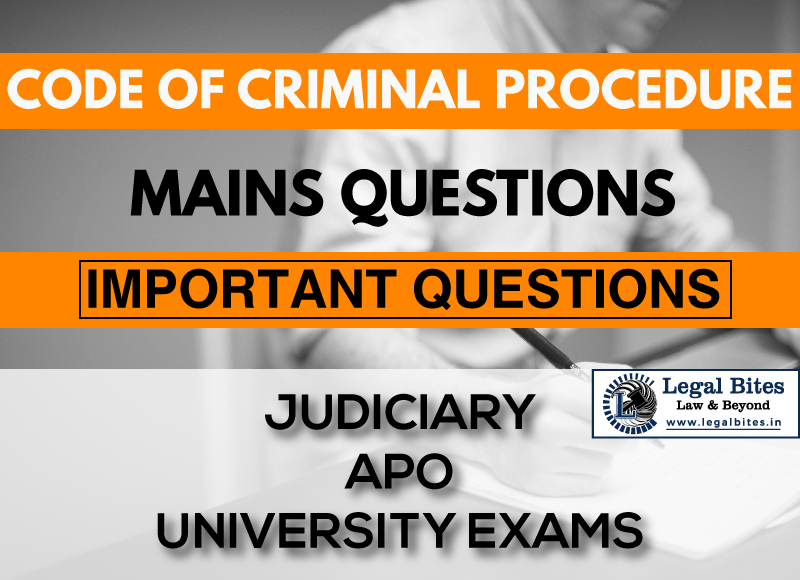Discuss the law relating to Public nuisance under Section 133 of the Code of Criminal Procedure, 1973.
Question: Discuss the law relating to Public nuisance under Section 133 of the Code of Criminal Procedure, 1973. [UPHJS 2018] Find the answer to the mains question only on Legal Bites. [Discuss the law relating to Public nuisance under Section 133 of the Code of Criminal Procedure, 1973.] Answer Nuisance is an obstruction, risk, or injury to life, health,… Read More »

Question: Discuss the law relating to Public nuisance under Section 133 of the Code of Criminal Procedure, 1973. [UPHJS 2018] Find the answer to the mains question only on Legal Bites. [Discuss the law relating to Public nuisance under Section 133 of the Code of Criminal Procedure, 1973.] Answer Nuisance is an obstruction, risk, or injury to life, health, comfort, or convenience and if it causes damage to all persons within the sphere of its activity it is a public nuisance. An...
Question: Discuss the law relating to Public nuisance under Section 133 of the Code of Criminal Procedure, 1973. [UPHJS 2018]
Find the answer to the mains question only on Legal Bites. [Discuss the law relating to Public nuisance under Section 133 of the Code of Criminal Procedure, 1973.]
Answer
Nuisance is an obstruction, risk, or injury to life, health, comfort, or convenience and if it causes damage to all persons within the sphere of its activity it is a public nuisance.
An interpretation of Section 133 (1) of CrPC will lead to the inference that ‘public nuisance’ includes any or all of the following acts:
First – any unlawful obstruction in any public place or from anyway, river or channel which is or may be lawfully used by the public,
Second – any trade or occupation, or any goods or merchandise, the conduct of which is injurious to the health or physical comfort of the community,
Third – construction of any building or disposal of any substance which is likely to cause fire or explosion,
Fourth – any building, tent, structure, or tree that is in such a condition which is likely to fall and cause injury to persons in the neighbourhood,
Fifth – any unfenced tank, well, or any excavation which lies adjacent to anyway or public place and
Sixth – any dangerous animal that may cause injury.
In Ram Kishore v. State 1973 Cri. L.J 1527 (HP), the court held that “a place in order to be public must be open to the public, i.e., place where the public has access by right, permission or usage”.
Further, in Vasant Manga v. Baburao Naidu (1996) SCC (Cri) 27, the court held that “community cannot be taken to mean residents of a particular house. It means something much wider than that.”
According to Section 133, upon receiving any reasonable information regarding the commission or omission of acts that cause a public nuisance, the appropriate Executive Magistrate can exercise his powers under Section 133.
The provision empowers the Magistrate to take evidence to support its belief that public nuisance is being committed in some part under its jurisdiction.
After receiving the information and taking evidence, if the Magistrate is satisfied that one of the six circumstances aforementioned under Section 133 (1) exists, he may order the appropriate person to;
- Remove such obstruction or nuisance,
- To desist or take adequate measures to regulate the trade and occupations that are injurious to public health and safety,
- To restrain the construction of any establishment which is constructed illegally and before the decree of the civil court in that regard,
- To remove, repair or replace or otherwise fix the building or any other construction or tree which is in a falling condition,
- To fence such tank, well or excavation which is unfenced and hence, threat,
- To destroy, confine or otherwise dispose of such hazardous animals who pose a threat to society.
To exercise the power of removal of public nuisance, the following are the sine qua non:
- The nuisance must be public and affect the members of the society as a whole and thus, can be removed from a public place,
- There must be an imminent danger to property and a consequential nuisance to the public,
- If the Magistrate does not take any action and direct the public to take recourse to the ordinary course of law, irreparable damage should be caused and
- Obstruction or nuisance should be an invasion of public rights and individual rights.
Important Mains/Long Questions for Judiciary, APO & University Exams
- CRPC Mains Questions Series Part I: Important Questions
- CRPC Mains Questions Series Part II: Important Questions
- CRPC Mains Questions Series Part III: Important Questions
- CRPC Mains Questions Series Part IV: Important Questions
- CRPC Mains Questions Series Part V: Important Questions
- CRPC Mains Questions Series Part VI: Important Questions
- CRPC Mains Questions Series Part VII: Important Questions
- CRPC Mains Questions Series Part VIII: Important Questions
- CRPC Mains Questions Series Part IX: Important Questions
- CRPC Mains Questions Series Part X: Important Questions
- CRPC Mains Questions Series Part XI: Important Questions
Admin Legal Bites
Legal Bites Study Materials correspond to what is taught in law schools and what is tested in competitive exams. It pledges to offer a competitive advantage, prepare for tests, and save a lot of money.
